When can baby have peanut butter? And how do you introduce peanut butter to baby? Here are my three favorite ways to offer peanut butter to a baby and simple tips to keep in mind when introducing it for the first time.
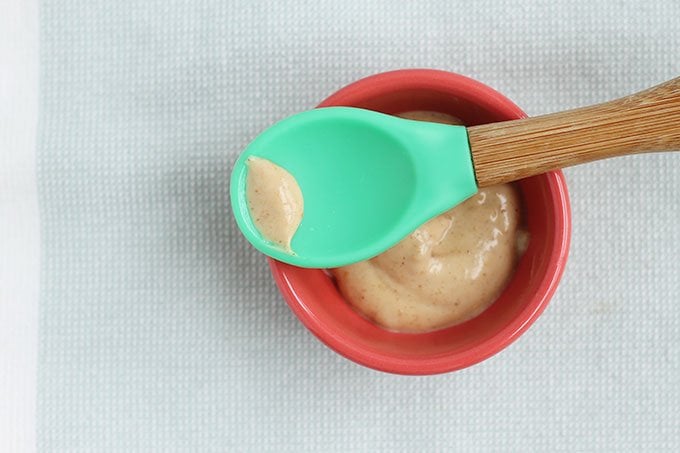
The American Academy of Pediatrics recommends that potentially allergenic foods be introduced early on when starting solids at 6 months. This advice has changed recently, and family members may not realize that it’s no longer advised to wait until a child turns 1.
In fact, waiting can actually increase the likelihood of an allergic reaction, so it’s important to introduce peanut butter baby food early and often to lower the risk.
(You may also like Baby Pancakes, Sweet Potato Baby Food, Carrot Baby Food, and when can baby have eggs.)
Table of Contents
- How to Introduce Peanut Butter to a Baby Step-by Step
- What to Know About Peanut Allergy Symptoms
- Best Peanut Butter for Babies
- How to Avoid Choking With Peanut Products
- How to Introduce Peanut Butter to Baby
- Peanut Butter Toast for Baby
- Peanut Butter Puffs
- Peanut Butter Puree for Baby
- How to Make Peanut Butter Puree Step-by-Step
- Frequently Asked Questions
- Best Tips for Peanut Butter and Baby
- Easy Peanut Butter Baby Food Puree Recipe
How to Introduce Peanut Butter to a Baby Step-by Step
According to the National Institute of Allergy and Infectious Diseases, start by considering which group your child falls into:
- They have severe eczema and/or an egg allergy. In this case, talk with your doctors about peanut allergy testing and testing a peanut product for the first time in their office. Babies in this group are advised to get their first peanut product between 4 and 6 months.
- They have mild or moderate eczema. Talk to your doctor, but it is likely safe to introduce peanut products around the 6 month mark.
- They have no signs of eczema or food allergies. Offer peanut products soon after starting solids as you introduce all sorts of other foods.
TIP: Talk to your pediatrician about any concerns you have, at any time. If you are at all worried, you can always introduce a peanut product in their office with their supervision to alleviate your stress. Just talk to them about your plan ahead of time.
What to Know About Peanut Allergy Symptoms
Typically, they appear soon after introducing the food. Symptoms of a peanut allergy may include anaphylaxis (which is the most severe), but also vomiting, indigestion, diarrhea, wheezing, repetitive coughing, tightness in the throat, hives, swelling in the mouth, and more.
Diagnosing any food allergy can be complicated, so your best bet is to see a pediatric allergist.
TIP: The good news is that research has shown up to 20 percent of individuals with a peanut allergy eventually outgrow it.
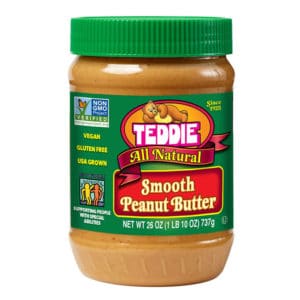
Best Peanut Butter for Babies
Look for a peanut butter without added sugar and opt for creamy to ensure that the texture is smooth for baby. I like Smucker’s Natural Peanut Butter, Whole Foods 365 Store Brand, and Teddie.
There are many other options available, so just check the ingredients and look for one without added cane sugar or honey.
How to Avoid Choking With Peanut Products
The simplest way to avoid choking is to never offer actual whole peanuts. You should also avoid chunky peanut butter, which will be difficult (and potentially dangerous) for a baby. Also avoid spoonfuls of straight peanut butter which can get stuck in their mouths.
See below for safe peanut options for baby.
How to Introduce Peanut Butter to Baby
I have three favorite ways that I will outline below. They include:
- Peanut Butter Toast
- Peanut Butter Puffs
- Peanut Butter Puree
TIP: I recently saw a tip about grinding nuts into a powder to mix into other foods like oatmeal, which is another great option. The first time you offer peanut butter, it makes sense to limit the other foods in the same meal so you can easily isolate the cause if there’s a reaction.
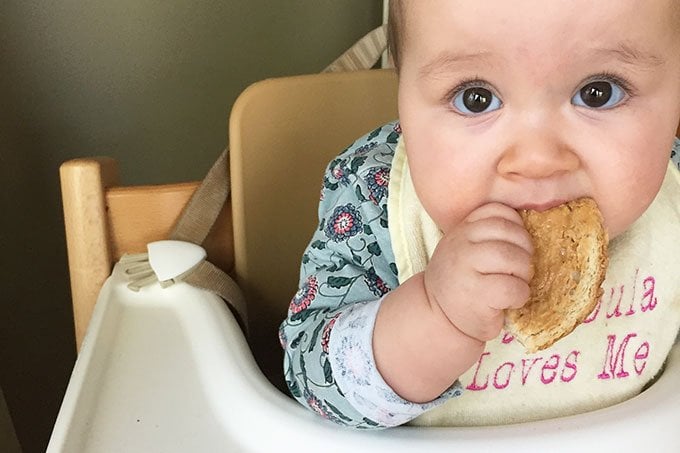
Peanut Butter Toast for Baby
A simple way to offer peanut butter to baby is to spread a very thin layer onto a piece of lightly toasted bread. This is a classic baby led weaning food approach where you cut the toast into a piece that’s at least as big as your finger so it’s way too big for the baby to put the entire thing into their mouth.
This is easy for a baby, even one as young as 6 months, to pick up and suck on. (This also works really well with mashed hard cooked egg yolk!)
TIP: Do be sure to lightly toast the bread to reduce the chances that a piece of soft bread will get stuck onto the roof of their mouth.
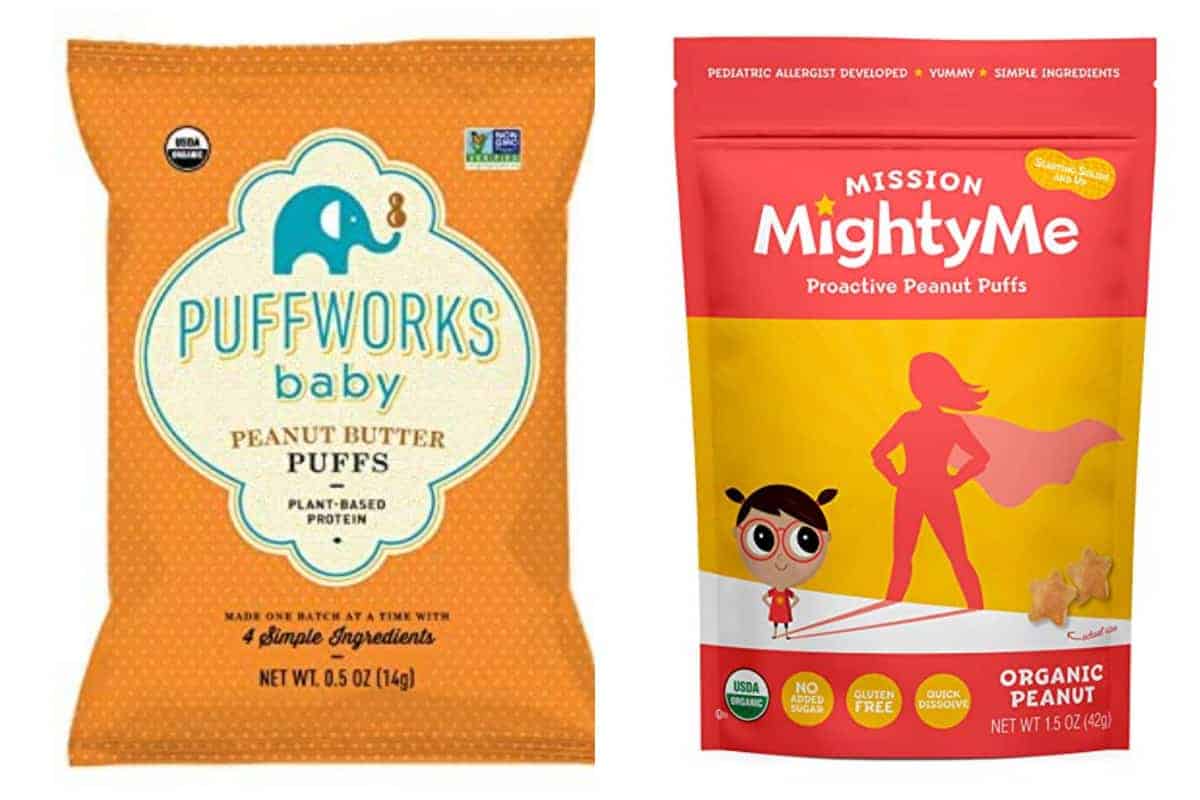
Peanut Butter Puffs
Another easy way to offer peanut butter to a baby or toddler is to use store-bought peanut butter puffs. The most commonly known one is called Bamba Puffs and Puffworks Baby also makes one. You can find them at Trader Joe’s and on Amazon. They are my favorite because they are big enough for a baby to suck on without putting the entire thing into their mouth.
Peanut Puffs from Mission Mighty Me are a nice option once babies develop their pincer grasp around 9 months.
TIP: The great thing about these puffs is that they dissolve easily in baby’s mouth, are easy to hold, and are a healthy snack food you can continue serving through toddlerhood.
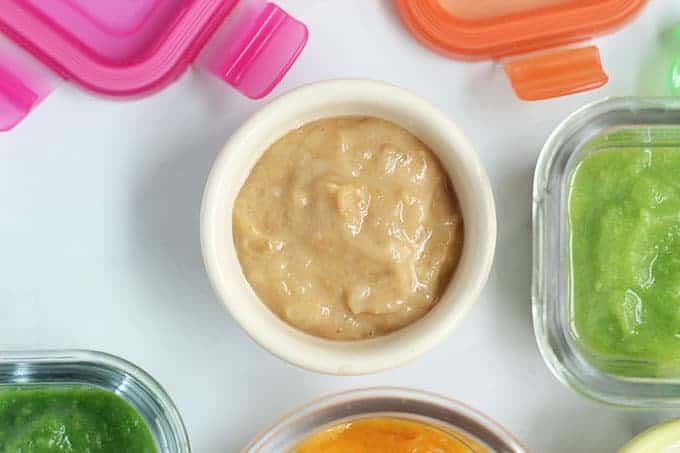
Peanut Butter Puree for Baby
My very favorite way to introduce peanut butter for the first time is to make it into a fluffy puree. It’s so easy, it’s good, and it’s very nutritious with health fats and protein. It’s a perfect no-cook baby food to make at home.
To make this puree, you just need natural creamy peanut butter and water. The water helps to fluff up the peanut butter, making it into a yogurt-like consistency.
It’s smooth and flavorful and can be stored for later, too.
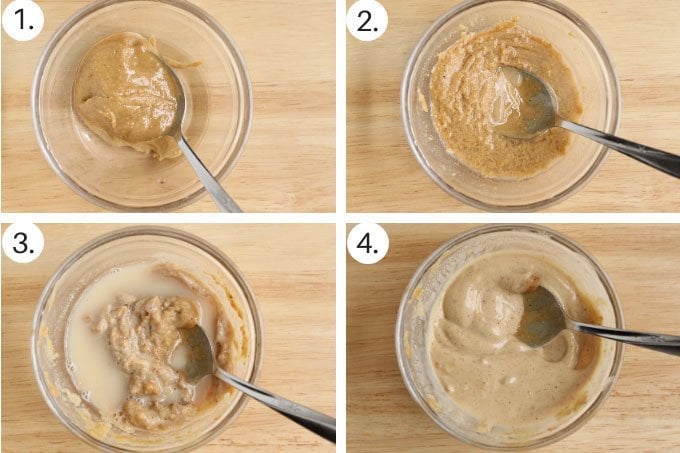
How to Make Peanut Butter Puree Step-by-Step
Here’s a look at how to make a simple peanut butter baby food.
- Add peanut butter and water to a bowl.
- Start stirring together.
- Keep stirring together as the water begins to look cloudy.
- Keep stirring together until the mixture is a uniform texture and color.
TIP: Room temperature peanut butter and/or warmish water make this come together a little more easily than cold peanut butter.
Frequently Asked Questions
You can introduce peanut butter soon after starting solids, or around 6 months of age. Talk to your pediatrician if you have any concerns.
According to experts at Mass General Hospital, they recommend to introduce the first bite, then wait 10 minutes for a reaction. If there is none, continue feeding. Typically, a reaction to peanut butter will appear soon after introducing the food. Symptoms of a peanut allergy may include anaphylaxis (which is the most severe), but also things including vomiting, indigestion, diarrhea, wheezing, repetitive coughing, tightness in the throat, hives, swelling in the mouth, and more.
Choose unsweetened smooth peanut butter without added sugar or honey for a baby.
Best Tips for Peanut Butter and Baby
- Store any peanut butter puree leftovers in an airtight container in the fridge for up to 5 days.
- Keep stirring if the mixture looks separated. It may take a full minute or more of stirring until the mixture comes together.
- If it seems thick or sticky, thin it out with additional water.
- Choose creamy natural peanut butter without added sugar.
- Offer a small amount on a spoon, on its own, or mixed with a vegetable puree or fruit puree, or spread a thin layer onto a 1-2 finger-size piece of toast.
- Stop feeding baby when they turn their head away and close their mouth. (The serving size below is just a ballpark guess.)
- Consider a peanut puff like the ones from Puffworks Baby.
- Avoid large clumps or spoonfuls of peanut butter as that can be a choking hazard.
- Incorporate peanut butter, in consultation with your pediatrician, with other solid foods and formula or breast milk after baby has started solids, or around 6 months of age.
- If baby has or had eczema or other food allergies, check with your pediatrician for guidance on introducing food allergens.
Related Recipes
Baby Food
When can baby eat eggs?
Baby Food
10 Easy Homemade Baby Food Ideas
Starting Solids
Baby Food Chart: BLW, Purees, Finger Foods
I’d love to hear your feedback on this, so please comment below to share!
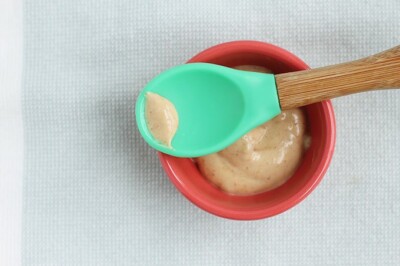
Easy Peanut Butter Baby Food Puree
Ingredients
- 1 tablespoon creamy natural peanut butter (without added sugar if possible)
- 2-3 tablespoons water
Instructions
- Add the peanut butter and 2 tablespoons water to a bowl.
- Stir until the mixture starts to come together and the color and consistency are uniformly light and somewhat fluffy. This will take a little bit of time so keep going if and when the peanut butter separates.
- Add water as needed to make a fluffy puree consistency.
- Offer on a spoon to baby in small amounts or spread onto a 1-2 finger-size piece of toast.
Video
Notes
- Store any leftovers in an airtight container in the fridge for up to 5 days.
- Keep stirring if the mixture looks separated. It may take a full minute or more of stirring until the mixture comes together.
- If it seems thick or sticky, thin it out with additional water.
- Choose creamy natural peanut butter without added sugar.
- Offer a small amount on a spoon or spread a thin layer onto a 1-2 finger-size piece of toast.
- Stop feeding baby when they turn their head away and close their mouth. (The serving size below is just a ballpark guess.)
Nutrition
This post was first published August 2020.
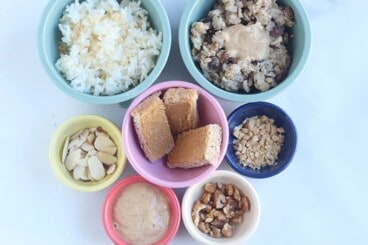
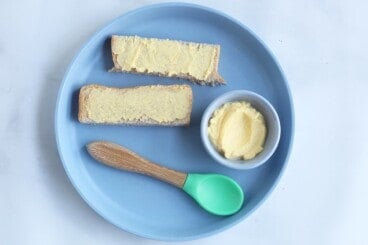
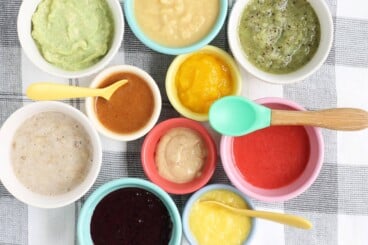
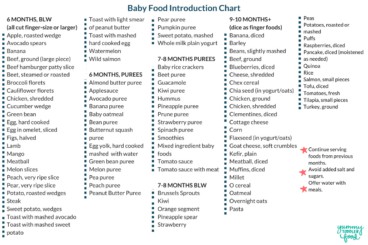
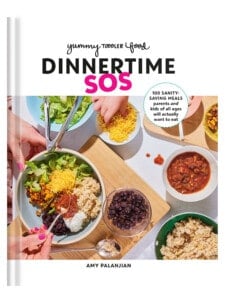
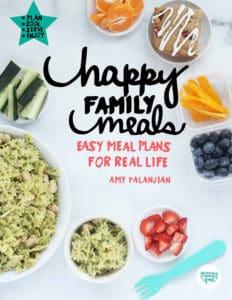
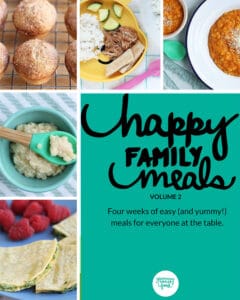
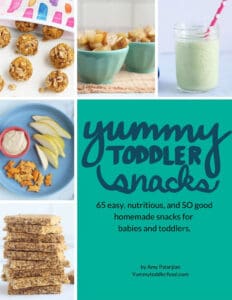











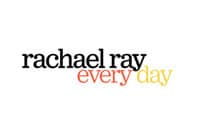


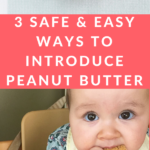
Would this recipe work just as easily with breast milk instead of water? Does this work well when freezing?
Yes and yes
At how many months of age is this safe to feed to a baby?
The puree is meant for after a baby starts solids, which is typically around 6 months.
Hi
Just came across you site on Google and I’ve already learned so much!!!
Can I sub water for formula?
How long can it be stored in the freezer if I mix it with a freshly made puree?
Hi and welcome! I haven’t tried it with formula and I think it will work but it may be thicker to start since the consistency of formula is so much thicker. So the ratios may be a little different. You can freeze it on its own or mixed with another puree for up to 6 months. Hope baby enjoys it!
Can I do the same with creamy almond butter as with peanut butter? Also I noticed it has the 3 feeding stages, my baby boy is almost 6 months so I intend to start introducing food to him soon, does this mean he can’t do BLW till 9 months? I’ve noticed that stage 3 is the stage that introduces finger foods. But I also saw your other article on BLW so I’m a bit confused as to whether I can offer him roasted sweet potato wedges and apples etc. at 6 months or if I am meant to wait till he’s older? Thanks much.
Hi- Yes, you can do this with creamy almond butter too. BLW is entirely outside of the traditional stages, so you can start that at 6 months. If you do a combined approach, you’d just look to transition from the bigger pieces of food to smaller bite size ones around 9 months. (So basically ignore the stages and just remember that you’ll eventually move away from the larger sizes as baby starts chewing more and learning to take bites. Let me know if you have more questions!
Hello Amy,
I am a first time mom, I have been a fan of your wonderful recipes as of this year when I discovered you on Google. I have made many of your great meals for my son. I have purchased organic peanut butter and will be trying it very soon, however, my question to you is this: can I add the peanut butter with any other purées? (Of course eventually, once I have given it a first try) It doesn’t seem to be filling enough as a meal on its own…
Sending lots of love from Ottawa,Canada
Hi- Yes, it’s a great addition to any other puree or whole milk yogurt. It actually may be filling on it’s own, but you can totally pair it. We like it with banana, yogurt, apple, oatmeal, rice cereal…
Can I sub breastmilk for water when making the puree?
Sure!
Hi! I have used my breast milk to introduce peanut butter purée. But I cannot find anywhere for storage info on this mix. I made quite a bit but I’m unsure how long this would last because of the milk
Hi- I think the best option would be to freeze small portions in an ice cube tray, then you know they’ll be safe and fresh for future weeks. I’d think the normal breast milk storage guidelines would apply otherwise.